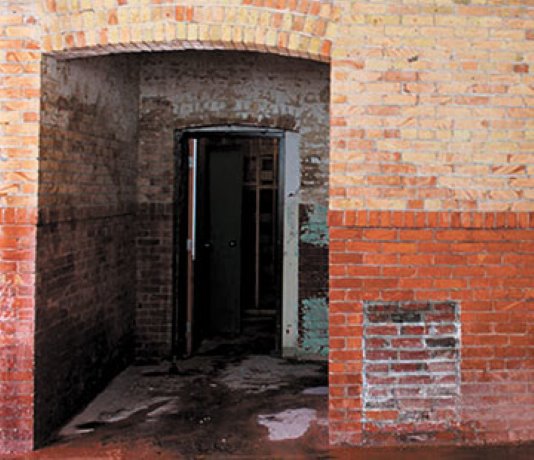More than 12,000 heritage bricks in an old Hamilton school are being restored to their former glory in an environmentally friendly manner.
Wickens Dry Ice Blasting, a Milton-based blasting, remediation, and decontamination firm is using a citrus-based paste known as inStripe to remove more than a century of residual paint off the interior bricks in the Stinson School, a huge red brick, red sandstone and limestone complex comprised of a 1894 north wing and 1914 south building.
“Rather than injuring the stone and asphyxiating the workers with sandblasting, we are coating the walls with the paste, which is left for a few days and then sprayed off with high-pressure hot water,” says Harry Stinson, project director and key principal in Stinson Developments.
The project management and development firm, which acts as its own general contractor, is nearing the end of a four-year undertaking to convert the school into loft units.
Stinson School is the original name and is being retained by the developer who didn’t have any connection with the building before buying it from the Hamilton Wentworth District School Board.
To maintain the structural and visual integrity of the building — as well as complying with local preservation restrictions and guidelines — Stinson and his partners began exploring less intrusive options for cleaning the brick in what will be the condominium’s lower level units. That exploration eventually led to the hiring of Wickens Dry Ice Blasting.
After a few sample test areas in the complex were tried out, Stinson was convinced of the paste’s effectiveness and gave the go ahead for a large scale treatment in the lower level, as well as some other areas of the complex.
As he describes it, the paint stripping process is straightforward. Using hand tools, workers roll the paste on the walls and then cover the walls with polyethylene to seal in the moisture so the product can work effectively. “If it dries out it stops working.”
After a period ranging anywhere from 24 to 48 hours, the plastic is removed and the paste and the paint washed off with high-pressure hot water, he says.
“It’s really quite amazing and actually smells interesting —strange for a construction site.”
By the time Wickens has completed its contract, approximately 12,500 bricks will have been cleaned. The work that’s being carried out has helped showcase the craftsmanship of the original brick workers, Stinson says.
“We have been peeling off a century of paint to reveal beautifully multi-coloured Hamilton bricks, carefully arranged in two-tone patterns.”
When asked what lessons other developers and contractors could draw from his experience, Stinson said: “The treatment works. It’s quite safe and versatile.”
Not only does the use of the paste avoid the use of sandblasting which can potentially damage brick and stone, it doesn’t interfere or prohibit other nearby construction work, he says.
The level of applicator expertise in its handling is Canada is limited, says Stinson, suggesting the applicator was somewhat overly optimistic in its scheduling projections.
But such painting removal projects are often loaded with unforeseen complications such as the use of different paints or even the use of different bricks in the same building, says Wickens construction division manager Simon Brown.
“We have an arsenal of materials,” says Brown, explaining that no two restoration/renovation projects are identical and the type of paint-stripping technique has to be adapted to each project.



Recent Comments
comments for this post are closed